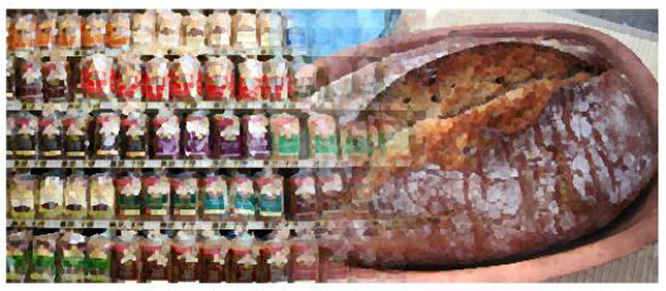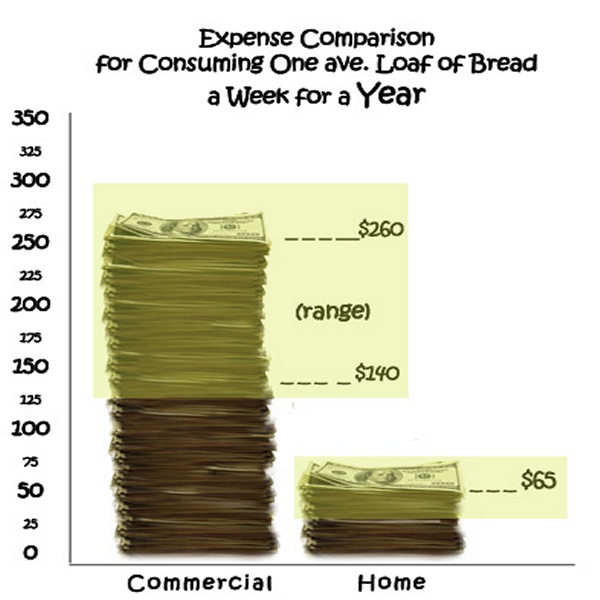



Learn About Sourdough
Media













Order Sourdough
Genuine Vs Commercial
What are the reasons behind all the recommendations to use sourdough starter to make home-made
bread, bagels, pizza, waffles etc, vs buying it at the store?
• Like most things in life, a good thing just cannot be packaged or processed. It always ends up
taking away some portion of the quality or essence of the food when creating something 'safe'
with a shelf life. At home you can determine your quality and freshness of nutrients that goes
into feeding your starter and baking your breads, and enjoy the heavenly pleasure of
hot-out-of-oven bread.
• It's quite common for commercial sourdough to be made from a pre-mixed packet of dried yeasts and other components that is similar to sourdough, but is not a true sourdough starter. These packets are more reliable, consistent and much quicker - allowing for ease of mass production. Unfortunately you lose the authentic nature and myriad of varieties, as well as some of the subtle nutritional enhancement that comes from a slowly fermented true sourdough starter. These packets are designed to nearly mimic the flavor of sourdough to please the taste buds of consumers.
• Slowly fermented sourdough (done the traditional way with starter) imparts more health benefits to the final loaf of bread because the slow action of bacteria and yeast help make the grain in the bread more digestible (much like soaking or sprouting beans), while at the same time curbing a sugar-spike in blood because of the additional acidic natural found in natural sourdough bread. Some studies are now showing that whole grain sourdough is even better for your health than regular whole grain bread, because of its natural and gradual impact on blood sugar.
• Did you know that sourdough doesn't need to be sour if you don't like sour bread? You can easily make a mild, sweet bread if you raise the dough quickly. This avoids the sour flavor that develops later on in the rise.
• Unlike packets of yeast or store-bought sourdough bread, sourdough starter is self-sustainable. You can make as much starter as you need, whenever you need, as long as you keep feeding it! Before the advent of yeast packets, miners and travelers all carried around a safely guarded little pouch of fresh sourdough starter to their new home.
• You know what is going in it - forget about worrying about what they use to preserve, condition, emulsify or flavor the bread with - this can be quite the ordeal when on a special diet or if you have allergies. No di-glycerides or sodium stearoyl lactylate involved here! Just flour, water and a little salt - simplicity is beautiful!
• An authentic sourdough starter is able to produce a unique and multi-dimensional flavor, which you can tweak to your tastes. Want it more sour? Ferment the loaf longer, want the bread not sour at all? You can do that with sourdough starter, too.
• The cost you will be saving is substational. Some bakeries do still keep a real sourdough starter on hand, however, you may find that the price you pay for their bread is much more at a bakery, and still quite a bit at a grocery store.
• The average cost of a loaf of bread is about $2.70. At a bakery you may pay even more, around $4.00-$5.00. If you go through a loaf a week that will cost in you in the range of $140-$260. On the other hand, the cost of the flour and water (and a pinch of salt perhaps) needed to make your own bread at home will cost you far less, coming out to only around $.32/lb for flour, which would cost on average about $65.00 a year for the same amount (a loaf a week).
• That is a substantial savings of up to approximately 75%! You can still easily come out ahead even after investing in some gourmet and fun flavorings (gourmet cheese, olives, fresh herbs, multi-grain mixes and seeds) to add to your sourdough with that kind of savings.
• It's quite common for commercial sourdough to be made from a pre-mixed packet of dried yeasts and other components that is similar to sourdough, but is not a true sourdough starter. These packets are more reliable, consistent and much quicker - allowing for ease of mass production. Unfortunately you lose the authentic nature and myriad of varieties, as well as some of the subtle nutritional enhancement that comes from a slowly fermented true sourdough starter. These packets are designed to nearly mimic the flavor of sourdough to please the taste buds of consumers.
• Slowly fermented sourdough (done the traditional way with starter) imparts more health benefits to the final loaf of bread because the slow action of bacteria and yeast help make the grain in the bread more digestible (much like soaking or sprouting beans), while at the same time curbing a sugar-spike in blood because of the additional acidic natural found in natural sourdough bread. Some studies are now showing that whole grain sourdough is even better for your health than regular whole grain bread, because of its natural and gradual impact on blood sugar.
• Did you know that sourdough doesn't need to be sour if you don't like sour bread? You can easily make a mild, sweet bread if you raise the dough quickly. This avoids the sour flavor that develops later on in the rise.
• Unlike packets of yeast or store-bought sourdough bread, sourdough starter is self-sustainable. You can make as much starter as you need, whenever you need, as long as you keep feeding it! Before the advent of yeast packets, miners and travelers all carried around a safely guarded little pouch of fresh sourdough starter to their new home.
• You know what is going in it - forget about worrying about what they use to preserve, condition, emulsify or flavor the bread with - this can be quite the ordeal when on a special diet or if you have allergies. No di-glycerides or sodium stearoyl lactylate involved here! Just flour, water and a little salt - simplicity is beautiful!
• An authentic sourdough starter is able to produce a unique and multi-dimensional flavor, which you can tweak to your tastes. Want it more sour? Ferment the loaf longer, want the bread not sour at all? You can do that with sourdough starter, too.
• The cost you will be saving is substational. Some bakeries do still keep a real sourdough starter on hand, however, you may find that the price you pay for their bread is much more at a bakery, and still quite a bit at a grocery store.
• The average cost of a loaf of bread is about $2.70. At a bakery you may pay even more, around $4.00-$5.00. If you go through a loaf a week that will cost in you in the range of $140-$260. On the other hand, the cost of the flour and water (and a pinch of salt perhaps) needed to make your own bread at home will cost you far less, coming out to only around $.32/lb for flour, which would cost on average about $65.00 a year for the same amount (a loaf a week).
• That is a substantial savings of up to approximately 75%! You can still easily come out ahead even after investing in some gourmet and fun flavorings (gourmet cheese, olives, fresh herbs, multi-grain mixes and seeds) to add to your sourdough with that kind of savings.
Homemade sourdough is one of the easiest ferments to do. You get to choose the type of
water (tap, mineral, spring) and simply mix it with the starter and flour of your choice, and let it set
out at room temperature to munch away. Then whenever you need to raise a lump of dough, stick
in a little of your fresh starter and you've got bread on the way!
You are able to choose your own ingredients and flavoring or other additional things to put in. This is a great thing for those sensitive to gluten in wheat, or just wanting to make some good old-fashioned rye bread, or cinnamon-raisin for example!
You are able to tweak it to satisfy your tastes and dietary needs, making it less or more sweet as needed (even after its done - its such a flexible culture to work with). This is great for diabetics or anyone concerned with the sugar content involved. You can make a high-fiber, whole grain bread, or a buttery sweet white bread.
You can experiment with other grains such as spelt, kamut, rye, or a gluten-free flour. You can also have a starter for each flour too - such as a rye starter for when you bake with rye, a white wheat starter, and a whole wheat starter - you get the idea!
You will have excess sourdough to do whatever you want with - it makes excellent scrap glue/paste (really!) and it's excellent to throw into your pancake or waffle batter too (so good!). Check out our recipes for more ideas.
You can dry the the extra and share with your family and friends - nothing like sharing something so simple full of so much delicious potential!
You are able to choose your own ingredients and flavoring or other additional things to put in. This is a great thing for those sensitive to gluten in wheat, or just wanting to make some good old-fashioned rye bread, or cinnamon-raisin for example!
You are able to tweak it to satisfy your tastes and dietary needs, making it less or more sweet as needed (even after its done - its such a flexible culture to work with). This is great for diabetics or anyone concerned with the sugar content involved. You can make a high-fiber, whole grain bread, or a buttery sweet white bread.
You can experiment with other grains such as spelt, kamut, rye, or a gluten-free flour. You can also have a starter for each flour too - such as a rye starter for when you bake with rye, a white wheat starter, and a whole wheat starter - you get the idea!
You will have excess sourdough to do whatever you want with - it makes excellent scrap glue/paste (really!) and it's excellent to throw into your pancake or waffle batter too (so good!). Check out our recipes for more ideas.
You can dry the the extra and share with your family and friends - nothing like sharing something so simple full of so much delicious potential!
Copyright © 2015 Yemoos Nourishing Cultures. All rights reserved.
Shop | Forum | Blog | Contact Us




























